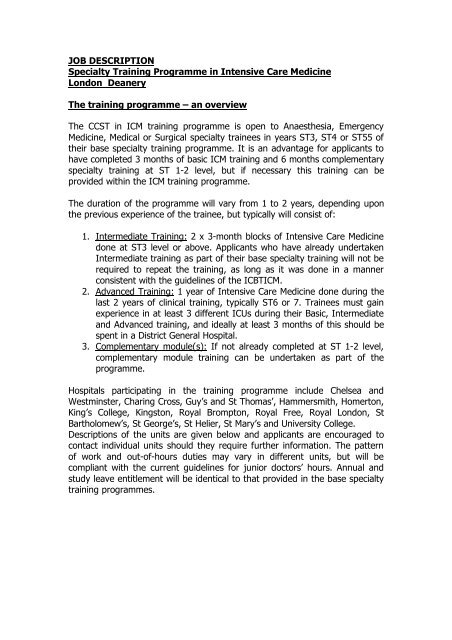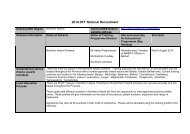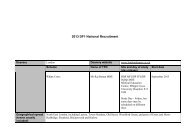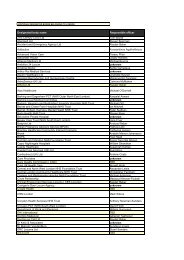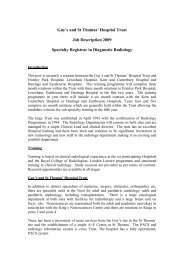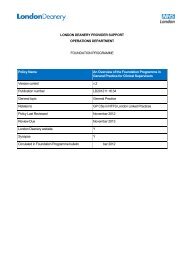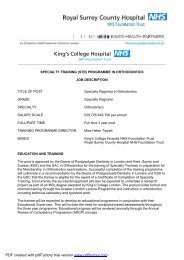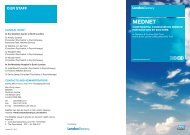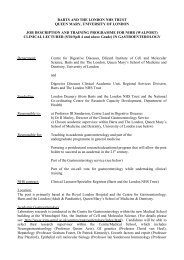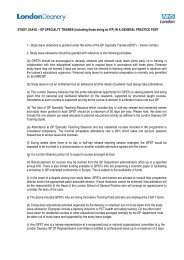CCT in ICM - programme overview unit ... - London Deanery
CCT in ICM - programme overview unit ... - London Deanery
CCT in ICM - programme overview unit ... - London Deanery
You also want an ePaper? Increase the reach of your titles
YUMPU automatically turns print PDFs into web optimized ePapers that Google loves.
JOB DESCRIPTION<br />
Specialty Tra<strong>in</strong><strong>in</strong>g Programme <strong>in</strong> Intensive Care Medic<strong>in</strong>e<br />
<strong>London</strong> <strong>Deanery</strong><br />
The tra<strong>in</strong><strong>in</strong>g <strong>programme</strong> – an <strong>overview</strong><br />
The CCST <strong>in</strong> <strong>ICM</strong> tra<strong>in</strong><strong>in</strong>g <strong>programme</strong> is open to Anaesthesia, Emergency<br />
Medic<strong>in</strong>e, Medical or Surgical specialty tra<strong>in</strong>ees <strong>in</strong> years ST3, ST4 or ST55 of<br />
their base specialty tra<strong>in</strong><strong>in</strong>g <strong>programme</strong>. It is an advantage for applicants to<br />
have completed 3 months of basic <strong>ICM</strong> tra<strong>in</strong><strong>in</strong>g and 6 months complementary<br />
specialty tra<strong>in</strong><strong>in</strong>g at ST 1-2 level, but if necessary this tra<strong>in</strong><strong>in</strong>g can be<br />
provided with<strong>in</strong> the <strong>ICM</strong> tra<strong>in</strong><strong>in</strong>g <strong>programme</strong>.<br />
The duration of the <strong>programme</strong> will vary from 1 to 2 years, depend<strong>in</strong>g upon<br />
the previous experience of the tra<strong>in</strong>ee, but typically will consist of:<br />
1. Intermediate Tra<strong>in</strong><strong>in</strong>g: 2 x 3-month blocks of Intensive Care Medic<strong>in</strong>e<br />
done at ST3 level or above. Applicants who have already undertaken<br />
Intermediate tra<strong>in</strong><strong>in</strong>g as part of their base specialty tra<strong>in</strong><strong>in</strong>g will not be<br />
required to repeat the tra<strong>in</strong><strong>in</strong>g, as long as it was done <strong>in</strong> a manner<br />
consistent with the guidel<strong>in</strong>es of the ICBT<strong>ICM</strong>.<br />
2. Advanced Tra<strong>in</strong><strong>in</strong>g: 1 year of Intensive Care Medic<strong>in</strong>e done dur<strong>in</strong>g the<br />
last 2 years of cl<strong>in</strong>ical tra<strong>in</strong><strong>in</strong>g, typically ST6 or 7. Tra<strong>in</strong>ees must ga<strong>in</strong><br />
experience <strong>in</strong> at least 3 different ICUs dur<strong>in</strong>g their Basic, Intermediate<br />
and Advanced tra<strong>in</strong><strong>in</strong>g, and ideally at least 3 months of this should be<br />
spent <strong>in</strong> a District General Hospital.<br />
3. Complementary module(s): If not already completed at ST 1-2 level,<br />
complementary module tra<strong>in</strong><strong>in</strong>g can be undertaken as part of the<br />
<strong>programme</strong>.<br />
Hospitals participat<strong>in</strong>g <strong>in</strong> the tra<strong>in</strong><strong>in</strong>g <strong>programme</strong> <strong>in</strong>clude Chelsea and<br />
Westm<strong>in</strong>ster, Char<strong>in</strong>g Cross, Guy’s and St Thomas’, Hammersmith, Homerton,<br />
K<strong>in</strong>g’s College, K<strong>in</strong>gston, Royal Brompton, Royal Free, Royal <strong>London</strong>, St<br />
Bartholomew’s, St George’s, St Helier, St Mary’s and University College.<br />
Descriptions of the <strong>unit</strong>s are given below and applicants are encouraged to<br />
contact <strong>in</strong>dividual <strong>unit</strong>s should they require further <strong>in</strong>formation. The pattern<br />
of work and out-of-hours duties may vary <strong>in</strong> different <strong>unit</strong>s, but will be<br />
compliant with the current guidel<strong>in</strong>es for junior doctors’ hours. Annual and<br />
study leave entitlement will be identical to that provided <strong>in</strong> the base specialty<br />
tra<strong>in</strong><strong>in</strong>g <strong>programme</strong>s.
DESCRIPTIONS OF UNITS PARTICIPATING IN THE PROGRAMME<br />
Char<strong>in</strong>g Cross Hospital<br />
Contact: Dr Doris Doberenz (0208 383 00 00 bleep 5742,<br />
ddoberenz@hhnt.nhs.uk)<br />
Char<strong>in</strong>g Cross Hospital has 550 beds and is part of the Hammersmith<br />
Hospitals NHS Trust (1000 beds <strong>in</strong> total) and Imperial College Medical School.<br />
The Intensive Care Unit is a modern facility on the 11 th floor with 12 general<br />
critical care beds. Also on the 11 th floor are two high dependency facilities (a<br />
9 bed surgical <strong>unit</strong> and a 13 bed neurosurgical <strong>unit</strong>), which are run by the<br />
base specialities <strong>in</strong> close cooperation with the <strong>in</strong>tensive care team. A 6 bed<br />
medical level 2 facility is on the 5th floor to which the ICU team also has an<br />
<strong>in</strong>put, as required. The cl<strong>in</strong>ical workload is complex due to the nature of the<br />
<strong>in</strong>stitution and this is reflected <strong>in</strong> the tra<strong>in</strong><strong>in</strong>g experience likely to be ga<strong>in</strong>ed.<br />
There is significant level 1 activity <strong>in</strong> the hospital, which forms the major work<br />
load of the outreach team (1 critical care nurse consultant and 2 G grades).<br />
There are about 500 ICU admissions per annum, 70 - 80% of whom are<br />
emergencies, with a mean length of stay of 7 days. Occupancy rate is<br />
constantly between 95 – 100%. The case-mix consists of general surgery,<br />
complex urology, vascular surgery, major head and neck cancer surgery,<br />
trauma, neurosurgery, neurology, general and respiratory medic<strong>in</strong>e,<br />
gastroenterology and oncology. Ultimate responsibility for admission to,<br />
discharge from and patient care on the ICU lies with the consultant <strong>in</strong>tensivist<br />
(‘closed ICU’) <strong>in</strong> consultation with the referr<strong>in</strong>g or other medical and surgical<br />
teams, with whom cooperation is usually very good. Every bed has<br />
standardized modular monitor<strong>in</strong>g <strong>in</strong>clud<strong>in</strong>g PiCCO, with <strong>in</strong>formation<br />
technology allow<strong>in</strong>g access to results and patient documentation. The <strong>unit</strong><br />
has a sophisticated critical care specific database (AcuBase), which provides<br />
for patient documentation, severity of illness assessment and complex<br />
analyses, which is adm<strong>in</strong>istered by a dedicated team of data collectors, audit<br />
and research nurses and has been operational s<strong>in</strong>ce 1992. The consultants<br />
are full time with commitments to critical care alone. They work for a week at<br />
a time to facilitate cont<strong>in</strong>uity of care. All junior staff work full shifts. The <strong>ICM</strong><br />
tra<strong>in</strong>ee forms part of a group of three “middle” grade tra<strong>in</strong>ees. The two<br />
others are a respiratory medic<strong>in</strong>e SpR and an <strong>in</strong>ternational cl<strong>in</strong>ical fellow who<br />
is usually a newly registered specialist. They work a shift pattern, which<br />
amounts to an average 43 hours per week (<strong>in</strong>clud<strong>in</strong>g weekends) and provides<br />
cover until midnight, presently with no overnight on-call (this is done by<br />
consultants, SHOs and the anaesthetic SpR). The actual rota is organised<br />
between the <strong>ICM</strong> tra<strong>in</strong>ee, SpR and cl<strong>in</strong>ical fellow themselves.
The <strong>ICM</strong> SpR duties (similar to those of the other two middle grades) are<br />
predom<strong>in</strong>antly on the ICU, however, there are critical care activities on the<br />
rema<strong>in</strong>der of the 11 th floor and elsewhere <strong>in</strong> which the tra<strong>in</strong>ee may become<br />
<strong>in</strong>volved if appropriate.<br />
The middle grade group works <strong>in</strong> close cooperation with the consultants and<br />
takes an active role <strong>in</strong> supervision and tra<strong>in</strong><strong>in</strong>g of the SHOs on the <strong>unit</strong>.<br />
All junior doctors, <strong>in</strong>clud<strong>in</strong>g SpR’s, get two <strong>in</strong>duction days, organized by the<br />
hospital and the local educational supervisor for <strong>in</strong>tensive care medic<strong>in</strong>e.<br />
Opport<strong>unit</strong>ies for education, tra<strong>in</strong><strong>in</strong>g, teach<strong>in</strong>g and management<br />
Two to three consultant ward rounds each day at 9 am, 4 pm and 9 pm with<br />
bed-side teach<strong>in</strong>g, and a daily meet<strong>in</strong>g or ward round with consultant or SpR<br />
<strong>in</strong> Infectious Diseases/Microbiology.<br />
Some ward rounds are delegated to or done by the SpR’s under consultant<br />
supervision.<br />
Monthly dedicated half day for critical care teach<strong>in</strong>g<br />
Release for the regional critical care lectures half day<br />
Weekly CX Hospital Grand rounds <strong>in</strong> term time<br />
Weekly anaesthetic department teach<strong>in</strong>g half day<br />
Bi-monthly Morbidity and Mortality meet<strong>in</strong>gs<br />
Monthly audit and research meet<strong>in</strong>g<br />
Bi-monthly <strong>unit</strong> multidiscipl<strong>in</strong>ary management meet<strong>in</strong>g<br />
Audit and Research<br />
There is an active research <strong>programme</strong>. Interest and studies have <strong>in</strong>cluded<br />
promotion of native renal function, antibiotic k<strong>in</strong>etics, the impact of<br />
physiotherapy on time to becom<strong>in</strong>g ventilator free, and presently ma<strong>in</strong>ly<br />
consist of a major exam<strong>in</strong>ation of enteral and parenteral nutrition and<br />
ventilator associated pneumonia, Selective Decontam<strong>in</strong>ation of the Digestive<br />
tract, the relative merits of antacid therapies, ethical issues regard<strong>in</strong>g bed<br />
management and a number of sponsored studies. Projects are developed and<br />
discussed <strong>in</strong> a monthly audit and research meet<strong>in</strong>g. Interested junior doctors<br />
usually carry out audit projects. Intermediate and advanced <strong>ICM</strong> tra<strong>in</strong>ee SpR’s<br />
are expected and encouraged to participate <strong>in</strong> all educational, audit and<br />
research activities and to develop their own projects. We would expect the<br />
SpR to aim for at least one publication dur<strong>in</strong>g their stay.<br />
Critical Care Staff<strong>in</strong>g at CXH<br />
Full time Intensive Care Consultants<br />
Dr Mark Palazzo – Chief of Service for Critical Care Medic<strong>in</strong>e for Hammersmith<br />
Hospitals NHS trust<br />
Dr Doris Doberenz – Local educational supervisor for Intensive Care Medic<strong>in</strong>e<br />
Dr Roseanne Meacher – Lead for cl<strong>in</strong>ical governance<br />
Dr Adrian Steele<br />
Dr Anthony Gordon – Locum Consultant<br />
Anaesthesia Consultants<br />
2 consultants for weekends on-call 1 <strong>in</strong> 7: Dr Brian Porter, Dr Lynda Webb
Tra<strong>in</strong>ees<br />
1 CCST <strong>in</strong> <strong>ICM</strong> tra<strong>in</strong>ee, <strong>in</strong>termediate or advanced (this post)<br />
1 SpR <strong>in</strong> Respiratory Medic<strong>in</strong>e regularly attached to ICU for six months<br />
1 <strong>in</strong>ternational Cl<strong>in</strong>ical Fellow<br />
1 senior SpR <strong>in</strong> Anaesthesia on-call for anaesthetic ICU duties<br />
1 junior SpR <strong>in</strong> Anaesthesia regularly attached for three months<br />
7 SHO’s from other base specialities (Medic<strong>in</strong>e, Surgery, A + E)<br />
Chelsea and Westm<strong>in</strong>ster<br />
Contact: Dr Neil Soni (0208-746-8000)<br />
The Intensive Therapy Unit<br />
The Intensive Therapy Unit is under the Service Directorship of Dr Neil Soni.<br />
There are currently 4 Intensivists <strong>in</strong>volved <strong>in</strong> runn<strong>in</strong>g the ITU; Drs Soni,<br />
Fauvel, Hayes and Keays. A fifth consultant is about to be appo<strong>in</strong>ted. The <strong>unit</strong><br />
has 11 <strong>in</strong>tensive care beds, of which 7 are ventilator beds and 4 function as<br />
ITU stepdown/HDU beds. At present there are 450 admissions per year<br />
through the <strong>unit</strong>, but this is ris<strong>in</strong>g s<strong>in</strong>ce the extra beds were opened, and is<br />
expected to <strong>in</strong>crease to 600 over the next 18 months. The occupancy rates of<br />
the ITU vary between 90 and 100%.<br />
It is a fully equipped modern <strong>unit</strong>, which caters for an extensive range of<br />
specialties <strong>in</strong>clud<strong>in</strong>g trauma, vascular surgery, general surgery, oncology and<br />
obstetrics.<br />
The Intensive Care Unit is staffed by members of the Anaesthetic<br />
Department. A SpR is allocated to the <strong>unit</strong> for a block of 3 months as part of<br />
their tra<strong>in</strong><strong>in</strong>g requirement. A senior SpR 3 or 4 is allocated to the <strong>unit</strong> for a<br />
period of 3 months at a time. These senior tra<strong>in</strong>ees select to do ITU. There is<br />
also a 1-2 yr post for CCST <strong>in</strong> <strong>ICM</strong> tra<strong>in</strong>ees. There is an active <strong>in</strong>terest <strong>in</strong><br />
research with a wide range of research <strong>in</strong>terests. There is a comprehensive<br />
audit process us<strong>in</strong>g Acubase for patient data. At present cl<strong>in</strong>ical audit is<br />
conducted <strong>in</strong> conjunction with the rest of the anaesthetic department.<br />
The consultant roster is based on a week on call at a time, thereby<br />
guarantee<strong>in</strong>g cont<strong>in</strong>uity of care. All admissions and discharges through ITU<br />
are at the discretion of the Consultant <strong>in</strong> charge of ITU. The Intensivist and<br />
the Intensive Care team is cl<strong>in</strong>ically responsible for the patient <strong>in</strong> the ITU with<br />
open consultation relevant medical teams and <strong>in</strong> particular the admitt<strong>in</strong>g<br />
team. The <strong>unit</strong> enjoys a good rapport with other specialties <strong>in</strong> the hospital.<br />
We are <strong>in</strong> the process of develop<strong>in</strong>g a more formal Outreach Service.<br />
Previously problems on the ward were referred to the ITU team for<br />
consultation. It is hoped that we will have a team of ITU tra<strong>in</strong>ed nurses who<br />
will provide ITU advice and assistance <strong>in</strong> the management of problems <strong>in</strong> ten<br />
acute ward areas. This team will be led by a Nurse Consultant <strong>in</strong> close<br />
consultation with the ITU Medical team.
The post<br />
This post will <strong>in</strong>volve be<strong>in</strong>g the SpR <strong>in</strong> Intensive Care Medic<strong>in</strong>e on a busy<br />
General Intensive care Unit with five Intensivists <strong>in</strong>volved who are on-call one<br />
week at a time. There is an active teach<strong>in</strong>g and research <strong>programme</strong> and<br />
close l<strong>in</strong>ks with the Brompton, Char<strong>in</strong>g Cross and Hammersmith Hospitals.<br />
Dur<strong>in</strong>g the time <strong>in</strong> this post, it is hoped that the SpR would be able to<br />
consolidate technical and practical procedural work and to have further<br />
education experience <strong>in</strong> Intensive Care Medic<strong>in</strong>e.<br />
Guy’s and St Thomas’ Hospital Trust<br />
Contact : Dr Angela McLuckie 020 7188 7188 extension 83049/<br />
Angela.McLuckie@gstt.nhs.uk<br />
The Critical Care department consists of two 15-bed ICUs <strong>in</strong> the East W<strong>in</strong>g at<br />
St Thomas’, a 13-bed ICU on the Guy’s site, a 6-bed medical HDU at St<br />
Thomas’ and a 4-bed surgical HDU, aga<strong>in</strong> at St Thomas’. Each <strong>unit</strong> is staffed<br />
by a dedicated team of medical staff, although staff rotate between <strong>unit</strong>s at<br />
regular <strong>in</strong>tervals. All beds are equipped with the most modern ventilators<br />
(<strong>in</strong>clud<strong>in</strong>g HFOV), <strong>in</strong>vasive monitor<strong>in</strong>g equipment (PiCCO, LICO, PAC) and the<br />
CareVue cl<strong>in</strong>ical <strong>in</strong>formation system. Calcium-Citrate haemodialysis and the<br />
Genius system supplement the more usual forms of renal replacement<br />
therapy. The <strong>unit</strong> also participates <strong>in</strong> the ICNARC national audit <strong>programme</strong>.<br />
Over 2500 patients are admitted each year with a variety cover<strong>in</strong>g all<br />
specialties with the exception of neurosurgery. Many regional tertiary services<br />
e.g. cardiothoracic, vascular, renal and pancreatic transplant surgery are<br />
based <strong>in</strong> the Trust. About 200 cases are referred from District General<br />
Hospitals, mostly for the management of ARDS and multiple organ failure.<br />
The <strong>unit</strong> has an active research <strong>programme</strong> undertak<strong>in</strong>g studies <strong>in</strong> the fields<br />
of sepsis and septic shock, haemodynamic monitor<strong>in</strong>g, ARDS,<br />
immunonutrition and renal replacement therapy.<br />
Staff<strong>in</strong>g<br />
Consultant staff:<br />
Nicholas Barrett<br />
Richard Beale<br />
Craig Davidson<br />
Guy Glover<br />
Nicholas Hart<br />
Andy Jones<br />
Boris Lams<br />
Chris Langrish
Richard Leach<br />
Angela McLuckie<br />
Manu Shankar-Hari<br />
Marlies Ostermann<br />
Marius Terblanche<br />
Ros Tilley<br />
David Treacher<br />
Adrian Williams<br />
Duncan Wyncoll<br />
Tra<strong>in</strong>ees:<br />
7 <strong>CCT</strong> <strong>in</strong> <strong>ICM</strong><br />
1 Cl<strong>in</strong>ical Fellow<br />
6 rotat<strong>in</strong>g STs <strong>in</strong> anaesthesia<br />
3 rotat<strong>in</strong>g STs <strong>in</strong> respiratory medic<strong>in</strong>e<br />
3 rotat<strong>in</strong>g STs <strong>in</strong> Acute Medic<strong>in</strong>e<br />
1 rotat<strong>in</strong>g tra<strong>in</strong>ee <strong>in</strong> GIM/Infectious Disease<br />
18 ST1-2 tra<strong>in</strong>ees from a variety of specialties <strong>in</strong>clud<strong>in</strong>g CMT, Anaesthesia<br />
and ACCS<br />
Duties of the post<br />
The post holder will take part <strong>in</strong> a resident, full-shift, band 1A rota (<strong>in</strong>volv<strong>in</strong>g<br />
1:7 night duties). Dur<strong>in</strong>g Step 2 the post holder will be expected to assume a<br />
greater level of responsibility e.g. conduct<strong>in</strong>g ward rounds under consultant<br />
supervision. Active participation <strong>in</strong> audit, teach<strong>in</strong>g and research will be<br />
expected.<br />
Teach<strong>in</strong>g <strong>programme</strong><br />
Tuesday 8.15 - 9am Journal Club/Morbidity and Mortality meet<strong>in</strong>g<br />
Wednesday 1300 – 1400 Staff Round<br />
Wednesday or Friday 8.15 – 9am Departmental Tutorial<br />
Daily microbiology ward round<br />
Bi-monthly audit meet<strong>in</strong>g<br />
Appo<strong>in</strong>tees will also be able to participate <strong>in</strong> the CME <strong>programme</strong>s with<strong>in</strong> the<br />
base specialty departments.<br />
Attendance at the 3 monthly <strong>London</strong> Intensive Care Group meet<strong>in</strong>gs is<br />
encouraged.<br />
Research opport<strong>unit</strong>ies<br />
Tra<strong>in</strong>ees spend<strong>in</strong>g more than 6 months <strong>in</strong> the <strong>unit</strong> are encouraged to<br />
undertake a research project. The specific project will depend upon the
<strong>in</strong>terests of the post holder. Assistance will be given for them to present the<br />
results of their research at both national and <strong>in</strong>ternational meet<strong>in</strong>gs.<br />
Other tra<strong>in</strong><strong>in</strong>g opport<strong>unit</strong>ies<br />
The appo<strong>in</strong>tee will have the opport<strong>unit</strong>y to attend management and<br />
comput<strong>in</strong>g courses. They will also be <strong>in</strong>volved <strong>in</strong> the ST1-2 <strong>in</strong>terview process,<br />
bus<strong>in</strong>ess plann<strong>in</strong>g for the ICU service, and <strong>in</strong>vited to attend relevant meet<strong>in</strong>gs<br />
between the consultants and f<strong>in</strong>ance/bus<strong>in</strong>ess managers.<br />
Base Hospital – Hammersmith<br />
Contact: Dr Adrian Steele (020 8743 2030, bleep 5626)<br />
The General Intensive Care Unit at ‘The Hammersmith Hospital’ is a 16bedded<br />
level 3 <strong>unit</strong>, which opened <strong>in</strong> the autumn of 2005. In addition there<br />
is a 6-bedded Cardiothoracic Intensive Care Unit run by the Cardiothoracic<br />
team and a Renal ‘Advanced Care’ facility run by the Nephrologists. The<br />
General Intensive Care staff frequently supports both these facilities<br />
The Hammersmith Hospital has a worldwide reputation as a centre of<br />
research and teach<strong>in</strong>g excellence. And is set to cont<strong>in</strong>ue as a vibrant and<br />
progressive medical facility. The Hospital shares its site <strong>in</strong> Du Cane Road,<br />
West <strong>London</strong>, with the Medical Research Council and the Imperial College<br />
School of Medic<strong>in</strong>e. The hospital deals with referrals from all over Brita<strong>in</strong> and<br />
with patients with rare diseases from all over the world. It provides regional<br />
services <strong>in</strong> several cl<strong>in</strong>ical areas <strong>in</strong>clud<strong>in</strong>g haematology and BMT. Cardio-<br />
Thoracic and Cardiological services are leaders <strong>in</strong> their field and require<br />
regular support from the General Intensive Care facilities. Recently the West<br />
<strong>London</strong> Renal Services (<strong>in</strong>clud<strong>in</strong>g Transplantation Services) have moved to a<br />
new block on the Hammersmith Campus.<br />
Historically 400 patients were admitted per year, many with complex<br />
medical conditions (this is likely to <strong>in</strong>crease with the <strong>in</strong>creased bed capacity).<br />
Surgical specialties supported <strong>in</strong>clude Hepatobiliary, Endocr<strong>in</strong>e, Renal<br />
Transplantation, major Gynaecology, complex Cardiac surgery, complex<br />
Obstetric. Medical sevices supported <strong>in</strong>clude Oncology, Neurology,<br />
Cardiology, Gastroenterology, Respiratory Medic<strong>in</strong>e, Infectious Diseases,<br />
Nephrology, Haematology and Bone Marrow Transplantation.<br />
Members of Staff:<br />
Consultant Dr Graham Baldock FRCA<br />
Dr Stephen Brett MD FRCA<br />
Dr Robert Broomhead FRCA<br />
Dr Par<strong>in</strong>d Patel FRCA<br />
Junior Staff 1 SpR (senior SpR tra<strong>in</strong>ee <strong>in</strong> <strong>ICM</strong>)<br />
1 SpR (anaesthetic SpR345 rotation)
The post<br />
1 Anaesthetic SpR 1,2 tra<strong>in</strong>ee<br />
1 Anaesthetic SHO tra<strong>in</strong>ee<br />
3 SHO’s from The Hammersmith SHO Medical Rotation<br />
3 SHO posts appo<strong>in</strong>ted by the <strong>ICM</strong> Dept.<br />
1) Cl<strong>in</strong>ical Education – Responsibility for the day to day management of all<br />
patients <strong>in</strong> conjunction with the Intensive Care Consultant. A full work<strong>in</strong>g<br />
ward round is held each morn<strong>in</strong>g, afternoon and even<strong>in</strong>g, <strong>in</strong>clud<strong>in</strong>g<br />
holidays and weekends. At the Hammersmith there are numerous<br />
opport<strong>unit</strong>ies to <strong>in</strong>teract with specialist colleagues who are equally keen to<br />
offer expertise and teach<strong>in</strong>g. We have a daily ward round with a<br />
Consultant <strong>in</strong> Microbiology or Infectious Diseases. A Consultant<br />
Radiologist reviews all radiographs with the team each weekday. We are<br />
also fortunate to have very dedicated and experienced pharmacists,<br />
physiotherapists and dieticians who support the medical and nurs<strong>in</strong>g staff.<br />
2) Adm<strong>in</strong>istration and Teach<strong>in</strong>g – The Senior tra<strong>in</strong>ee is currently adm<strong>in</strong>isters<br />
the rota of those more junior positions on the <strong>unit</strong>, and assists the<br />
consultant staff <strong>in</strong> the development and delivery of the teach<strong>in</strong>g<br />
<strong>programme</strong><br />
3) Audit and Research – Involvement <strong>in</strong> Cl<strong>in</strong>ical Service Improvement<br />
projects is expected; times permitt<strong>in</strong>g the juniors present an audit project<br />
to the multidiscipl<strong>in</strong>ary team dur<strong>in</strong>g their time on the <strong>unit</strong>. Participation <strong>in</strong><br />
research is also encouraged (and facilitated, if we possibly can).<br />
General adult <strong>in</strong>tensive care <strong>unit</strong> with 10 beds and approximately 350<br />
admissions each year. High porportion of patients requir<strong>in</strong>g haemofiltration.<br />
Particular <strong>in</strong>terests <strong>in</strong> complicated upper gastro<strong>in</strong>test<strong>in</strong>al surgery and acute<br />
<strong>in</strong>vasive cardiology. We also have regular cl<strong>in</strong>ical <strong>in</strong>volvement with patients <strong>in</strong><br />
the 10 bed cardiac surgical ICU/HDU.<br />
Consultants are Dr Graham Baldock (North West Thames Network Director),<br />
Dr Stephen Brett (Regional Educational Advisor) and Dr Adrian Steele. There<br />
are 2 registrars and 6 SHOs/RMOs.<br />
The rota will be resident 1 <strong>in</strong> 5 or 6.<br />
There is an active research <strong>programme</strong> that currently <strong>in</strong>cludes the genetic<br />
contributions to critical illness, and a follow up cl<strong>in</strong>ic to exam<strong>in</strong>e the long-term<br />
consequences of critical illness. From time to time <strong>in</strong>dustry-sponsored studies<br />
are undertaken. In addition, Dr Brett is a member of the North Thames ICU<br />
Blood Interest Group, and the <strong>unit</strong> contributes to multi centre studies coord<strong>in</strong>ated<br />
by this group. Future projects will <strong>in</strong>clude epidemiological studies<br />
<strong>in</strong> hospital <strong>in</strong>fection.<br />
There is an active <strong>programme</strong> of audits and there are opport<strong>unit</strong>ies for<br />
tra<strong>in</strong>ees to carry out audit projects and from time to time contribute to the<br />
research studies.
Homerton University Hospital<br />
Contact: Dr Lawrence Tham (020 8510 7300)<br />
This is a 500-bedded DGH situated <strong>in</strong> Hackney, east <strong>London</strong>. The ITU has 10<br />
beds and is a mixed medical-surgical <strong>unit</strong>. Admissions per year total between<br />
350 and 400 cases. Acute medical admissions make up approximately 60% of<br />
cases. The rema<strong>in</strong><strong>in</strong>g patients derive predom<strong>in</strong>antly from elective/emergency<br />
surgical work and obstetric emergencies. A substantial proportion of patients<br />
are admitted directly from the busy accident and emergency department.<br />
Nearly 60% of patients require mechanical ventilation on admission.<br />
There are 6 ITU consultants; 3 have general medic<strong>in</strong>e as their base specialty<br />
while the rema<strong>in</strong><strong>in</strong>g have an anaesthetic background:<br />
Dr. Bob Ghosh (ITU physician and lead cl<strong>in</strong>ician)<br />
Dr. John Coakley (ITU physician and Medical Director)<br />
Dr. David Watson (Senior lecturer <strong>in</strong> anaesthesia & <strong>in</strong>tensive care)<br />
Dr. Lawrence Tham (Consultant anaesthetist and local educational<br />
supervisor)<br />
Professor Charles H<strong>in</strong>ds (Professor <strong>in</strong> <strong>in</strong>tensive care medic<strong>in</strong>e)<br />
Dr. Karim Chadda (locum)<br />
The tra<strong>in</strong>ee will participate <strong>in</strong> ITU ward rounds and ward work, and will have<br />
an opport<strong>unit</strong>y to ‘lead’ ward rounds when appropriate. He/she should ga<strong>in</strong><br />
experience <strong>in</strong> perform<strong>in</strong>g percutaneous tracheostomies. There are fixed<br />
educational sessions with<strong>in</strong> the hospital, <strong>in</strong>clud<strong>in</strong>g a weekly postgraduate<br />
meet<strong>in</strong>g and weekly teach<strong>in</strong>g/lectures <strong>in</strong> the department of anaesthesia.<br />
Other tra<strong>in</strong>ees attached to the ITU <strong>in</strong>clude a surgical rotational SHO, a<br />
foundation SHO and an anaesthetic PRHO.<br />
K<strong>in</strong>g’s College Hospital<br />
Contact : Dr Elizabeth Wheatley/ Dr Julia Wendon (020 7346 3252)<br />
The Liver Intensive Care Unit<br />
The liver ITU is a specialist <strong>in</strong>tensive care <strong>unit</strong> and is part of the Institute of<br />
Liver studies and the Liver Care Group with<strong>in</strong> K<strong>in</strong>gs College Hospital. The<br />
Liver Care Group is composed of a multidiscipl<strong>in</strong>ary team of medical, nurs<strong>in</strong>g<br />
and paramedical staff car<strong>in</strong>g for patients with liver disease of all aetiologies.<br />
There is a hepatology component (<strong>in</strong> and out-patient work), a liver transplant<br />
<strong>programme</strong>, a hepatobiliary service and an <strong>in</strong>tensive care service. In addition<br />
to this there is a large and active research <strong>programme</strong>, with both cl<strong>in</strong>ical and<br />
basic laboratory research be<strong>in</strong>g undertaken.<br />
Complete dedicated diagnostic and therapeutic facilities are available for the<br />
specialist treatment of liver disease of all aetiologies. There is a ten bed adult<br />
<strong>in</strong>tensive care <strong>unit</strong> with facilities for support of multiple organ failure. (There
are separate paediatric liver ITU beds with<strong>in</strong> the department of paediatrics).<br />
The <strong>unit</strong> admits patients from the local ward environment, (liver and<br />
hepatobiliary), theatres (transplant and hepatobiliary) and other referr<strong>in</strong>g<br />
hospitals for the provison of tertiary liver and hepatobiliary <strong>in</strong>tensive care.<br />
Approximately 500 patients per year are admitted to the ITU, with a mean<br />
age of 48 years and an average mortality of 26%. Approximately 80% of<br />
patients are ventilated and 42% have renal failure. Approximately 100 cases<br />
per year will be admitted with acute liver failure. This cohort of patients are at<br />
risk of develop<strong>in</strong>g cerebral oedema and <strong>in</strong>tracranial pressure bolts are<br />
frequently <strong>in</strong>serted <strong>in</strong> those that become deeply encephalopathic.<br />
Hepatobiliary surgery accounts for 60-70 admissions a year , compris<strong>in</strong>g a<br />
mixture of elective surgery and liver trauma. Last year the Unit undertook 180<br />
liver transplants with adult cases account<strong>in</strong>g for 120. The other source of<br />
admissions are patients with sepsis and multiple organ failure who have had<br />
previous transplants or surgery and those with decompensated chronic liver<br />
disease. Increas<strong>in</strong>gly there are developments <strong>in</strong> the area of extracorporeal<br />
liver assist devices which are utilised <strong>in</strong> these patients groups.<br />
The liver surgery is performed <strong>in</strong> a dedicated theatre which is co-located with<br />
the Liver ITU and liver wards. One floor above the ITU there are laboratory<br />
services for the cl<strong>in</strong>ical service and research components of the Institute.<br />
There is active cl<strong>in</strong>ical research be<strong>in</strong>g undertaken with<strong>in</strong> the ITU area and<br />
staff are all encouraged to participate <strong>in</strong> such <strong>programme</strong>s.<br />
The ITU is staffed on a 1:1 nurse to patient ratio with a high proportion of<br />
ITU tra<strong>in</strong>ed nurs<strong>in</strong>g staff. The medical cover at consultant level is provided by<br />
2 full-time <strong>in</strong>tensivists, undertak<strong>in</strong>g weekday cover <strong>in</strong> one week blocks. Junior<br />
cover is provided by a full-time shift system of registrars from a background<br />
of <strong>in</strong>ternal medic<strong>in</strong>e, surgery and/or anaesthesia. The rota <strong>in</strong>volves a work<br />
pattern of 1 night shift <strong>in</strong> 7 and is compliant with junior doctors hours.<br />
Anaesthetic registrars from the liver rotation are also attached to the Unit as<br />
thetare commitments allow. A senior house officer is also attatched to the<br />
ITU, but does not partake <strong>in</strong> the on-call service. The on-call service for ITU<br />
tra<strong>in</strong>ees would probably be as on on-call form home if they wished <strong>in</strong> a<br />
“senior registrar “ type capacity with support from one of the consultant staff.<br />
The ITU is supported by a dedicated consultant microbiologist and 2 specialist<br />
pharmacists are attached to the liver service. The activity of the <strong>unit</strong> is<br />
audited us<strong>in</strong>g “R.I.P.” software, data is <strong>in</strong>put is undertaken by a dedicated<br />
nurse. All rout<strong>in</strong>e <strong>in</strong>vestigations are retrievable electronically. A consultant<br />
from radiology reviews the imag<strong>in</strong>g of the patients on a daily basis with<strong>in</strong> the<br />
liver ITU. There is excellent support from <strong>in</strong>terventional radiology and a<br />
weekly X-ray meet<strong>in</strong>g to review the images. Additionally there are dedicated<br />
dieticians and physiotherapists all of whom play <strong>in</strong>tegral roles <strong>in</strong> patient care.<br />
The <strong>unit</strong> is equipped to provide full ventilatory support at all beds, with a full<br />
range of <strong>in</strong>vasive monitor<strong>in</strong>g techniques. Renal support is achieved with<br />
haemofiltration and diafiltration and facilities exist to provide this <strong>in</strong> seven
eds at any one times. Facilities are available to monitor <strong>in</strong>tracranial pressure<br />
<strong>in</strong> patients with cerebral oedema.<br />
The consultants <strong>in</strong> the liver <strong>in</strong>tensive care undertake 2 ward rounds a day and<br />
there are multidiscipl<strong>in</strong>ary meet<strong>in</strong>gs each even<strong>in</strong>g with the transplant team to<br />
discuss patients <strong>in</strong> the ITU. The hospital has an active post- graduate<br />
education <strong>programme</strong> and <strong>in</strong> addition there is a regular <strong>programme</strong> with<strong>in</strong> the<br />
liver <strong>unit</strong> <strong>unit</strong> <strong>in</strong>corporat<strong>in</strong>g histology, X-ray meet<strong>in</strong>gs, case reviews, audit and<br />
cl<strong>in</strong>ical governance. Particular to the ICU area there is a weekly journal club,<br />
with regular cl<strong>in</strong>ical governance, audit and mortality and morbidity meet<strong>in</strong>gs.<br />
The Adult General Intensive Care Unit<br />
K<strong>in</strong>g’s College Hospital is fortunate <strong>in</strong> be<strong>in</strong>g one of the few <strong>London</strong> teach<strong>in</strong>g<br />
hospitals cover<strong>in</strong>g all the major specialties on one site. It functions as a level<br />
1 Trauma Unit, receiv<strong>in</strong>g frequent referrals from HEMS.<br />
The AICU is equipped for 18 beds, and is currently funded for 14. There are<br />
separate general HDU (10 beds) and neurosurgical HDU (10beds). Three<br />
month rotations to the Liver Intensive Care Unit or PICU are possible for<br />
those <strong>in</strong>terested. Dr Max Erv<strong>in</strong>e (Director) and four other consultants (three<br />
anaestheticts, one physician) provide cont<strong>in</strong>uous cover to the AICU.<br />
The post would entail participation <strong>in</strong> the day to day runn<strong>in</strong>g of the AICU and<br />
HDU, with the opport<strong>unit</strong>y to lead ward rounds and make management<br />
decisions. The on-call rota is a 1:5 partial shift, with consultant cover from<br />
home. Participation <strong>in</strong> the <strong>ICM</strong> teach<strong>in</strong>g <strong>programme</strong> and research are actively<br />
encouraged<br />
The Royal Brompton Hospital<br />
Contact: Dr Jeremy Cord<strong>in</strong>gley (0207-352-8121)<br />
The Royal Brompton Hospital, part of the Royal Brompton and Harefield NHS<br />
Trust, is a 300 bedded specialist cardiothoracic hospital for both adult and<br />
paediatric patients. The hospital is located <strong>in</strong> Chelsea adjacent to the Royal<br />
Marsden Hospital and is a short walk from South Kens<strong>in</strong>gton tube station.<br />
The Adult Intensive Care Unit is a 20 bedded facility (currently funded to 16<br />
staffed beds) and is with<strong>in</strong> the Department of Anaesthesia and Intensive Care<br />
Medic<strong>in</strong>e. There are approximately 1200 admissions per year and these are<br />
ma<strong>in</strong>ly cardiac and thoracic surgical patients. About 150 admissions per year<br />
are medical admissions referred by the departments of cardiology (<strong>in</strong>clud<strong>in</strong>g<br />
GUCH) and respiratory medic<strong>in</strong>e. In addition the <strong>unit</strong> accepts direct referrals<br />
of patients with acute pulmonary failure from other <strong>in</strong>tensive care <strong>unit</strong>s. The<br />
hospital conta<strong>in</strong>s a five bedded overnight post surgical recovery <strong>unit</strong> and five<br />
high dependency areas located with<strong>in</strong> wards.
Four Consultants have sessions <strong>in</strong> Intensive Care Medic<strong>in</strong>e and cover the <strong>unit</strong><br />
for one week at a time. In addition there are daily Consultant-led radiology<br />
and microbiology meet<strong>in</strong>gs. Junior medical staff<strong>in</strong>g comprises four Specialist<br />
Registrars and six Senior House Officers. The Specialist Registrars work a<br />
resident 1 <strong>in</strong> 8, 24 hour partial shift rota.<br />
There is an organised educational <strong>programme</strong> that <strong>in</strong>cludes regular teach<strong>in</strong>g<br />
and journal club sessions, multidiscipl<strong>in</strong>ary <strong>in</strong>tensive care meet<strong>in</strong>gs,<br />
departmental audit and morbidity and mortality meet<strong>in</strong>gs. Tra<strong>in</strong>ees are<br />
encouraged to contribute to audit, teach<strong>in</strong>g and research projects and are<br />
allocated non-cl<strong>in</strong>ical time for these activities.<br />
The academic Unit of Critical Care of the National Heart and Lung Institute,<br />
Imperial College, led by Professor TW Evans, is located at the Royal Brompton<br />
Hospital and is active <strong>in</strong> both basic science and cl<strong>in</strong>ical research <strong>in</strong> the<br />
<strong>in</strong>tensive care <strong>unit</strong> with a particular <strong>in</strong>terest <strong>in</strong> vascular biology and the acute<br />
respiratory distress syndrome (ARDS). Research fellows participate <strong>in</strong> the<br />
registrar on-call rota.<br />
The Royal Free Hospital<br />
Contact: Dr. Julian Howard ( 020 7794 0500)<br />
The Royal Free Hospital has a total complement of 20 Level 3 Intensive Care beds.<br />
A further 4 beds are due to be commissioned <strong>in</strong> due course. All medical and surgical<br />
specialties, with exception of cardiothoracic surgery are covered. The Renal Unit at<br />
the Royal Free provides services for the whole of the North Central sector. Tertiary<br />
specialist services <strong>in</strong>clude liver transplantation, hepatobiliary surgery and<br />
neurosurgery. All modern treatment modalities are catered for with the exception of<br />
ECMO. The total throughput of patients is <strong>in</strong> excess of 1100 per year.<br />
Senior medical cover is provided by 8 consultants. These consultants provide a 24<br />
hour per day 7 day per week service worked <strong>in</strong> blocks to provide cont<strong>in</strong>uity. Dr<br />
Steve Shaw is the Lead Consultant and Medical Lead for the North Central <strong>London</strong><br />
Critical Care Network. Dr Julian Howard is the Deputy Lead and Educational<br />
Supervisor. The other consultants are Dr. Y Rajal<strong>in</strong>gam Dr. B. Agarwal, Dr T.<br />
Berlet, Dr. A. Genahr and Dr K Dhadwal. Comprehensive ward rounds at 08.00hrs<br />
and 16.30hrs take place on a daily basis. All potential admissions to the <strong>unit</strong> be it<br />
day or night are discussed with the ITU consultant. There is a high level of support<br />
to the junior staff. There are weekly teach<strong>in</strong>g sessions on Tuesday and Thursday<br />
morn<strong>in</strong>gs and on Tuesday afternoons. There is a daily microbiology ward round and<br />
X-ray meet<strong>in</strong>g. We actively participate <strong>in</strong>, and regularly present at the medical<br />
ground round.<br />
Junior staff<strong>in</strong>g is provided by 13 doctors work<strong>in</strong>g a full shift rota ( new deal and<br />
EWTD compla<strong>in</strong>t). There six specialist registrars from the School of Anaesthesia,<br />
one NTN <strong>in</strong> respiratory medic<strong>in</strong>e, one CSST post <strong>in</strong> <strong>in</strong>tensive care and five Trust
senior cl<strong>in</strong>ical fellows and SHOs. The <strong>in</strong>tention is to convert two of the senior cl<strong>in</strong>ical<br />
fellow posts <strong>in</strong>to two NTN’s <strong>in</strong> acute medic<strong>in</strong>e.<br />
There is a dedicated ITU Pharmacist, Dietician, Physiotherapist and Cl<strong>in</strong>ical Scientist.<br />
There is active participation <strong>in</strong> audit – nationally with the INCNARC Case Mix<br />
Programme and locally with generic and research data.<br />
We have also developed a successful patient risk and outreach team supported by a<br />
nurse consultant, (Dr. Carol Ball).<br />
The Royal <strong>London</strong> Hospital<br />
Contact: Dr Marie Healy (0207-377-7793, mob 07813 783725)<br />
The Royal <strong>London</strong> Hospital (RLH) forms part of Barts and the <strong>London</strong> Trust.<br />
The RLH ICU is a tertiary referral <strong>unit</strong> for neurosurgery, trauma, vascular and<br />
renal services, and caters for a large deprived local population. The RLH is the<br />
base hospital for the Helicopter Emergency Medical Service and the Accident<br />
and Emergency Department caters for 100,000 patients per year. We are<br />
currently funded for 16 ICU beds (this may soon <strong>in</strong>crease to 18). There is a<br />
12 bedded surgical HDU (currently staffed for 5 beds). A Patient at Risk<br />
Team (ICU Outreach Team) was set up <strong>in</strong> 2001 and consists of one medical<br />
and one nurse consultant, a senior physiotherapist and 2 F grade nurses. An<br />
ICU out-patient follow-up cl<strong>in</strong>ic has recently been established. The ICU has a<br />
dedicated laboratory, sem<strong>in</strong>ar room, X ray room / tra<strong>in</strong>ee office, consultant<br />
office, on call room and relatives room. There are ongo<strong>in</strong>g research<br />
opport<strong>unit</strong>ies (cl<strong>in</strong>ical and laboratory based).<br />
We have approximately 700 admissions per year (most children are<br />
transferred). Bed occupancy runs at 92-95%. 14% of admissions are planned.<br />
80% of patients are ventilated. Up to 10% of patients have had CPR <strong>in</strong> the 24<br />
hours prior to admission. Case mix for the year end<strong>in</strong>g Dec 2002 <strong>in</strong>cludes<br />
neurosurgery / neurology 222, general surgery 192 and general medic<strong>in</strong>e<br />
141. Other subspecialties <strong>in</strong>clude major head and neck, upper GI and<br />
hepatobiliary surgery. ICU mortality runs at 22-25%. Approximately 30% of<br />
the ICU patient bed days are trauma related, <strong>in</strong>clud<strong>in</strong>g those with head <strong>in</strong>jury.<br />
There are 400 trauma calls per year and each is attended by an ICU doctor.<br />
We have extensive experience <strong>in</strong> ICU audit and participate <strong>in</strong> ICNARC.<br />
There are 2 consultant ward rounds per day and daily microbiology ward<br />
rounds. There is an active educational <strong>programme</strong>. We have weekly x-ray and<br />
trauma radiology meet<strong>in</strong>gs. We have a dedicated ICU teach<strong>in</strong>g session each<br />
week and a weekly ICU journal club.<br />
We have 8 consultants who staff the Unit (3 senior lecturers and 5 NHS<br />
consultants).<br />
Dr David Goldhill, Director of ICU, Barts and the <strong>London</strong> Trust<br />
Dr Stuart With<strong>in</strong>gton, Director of ICU, Royal <strong>London</strong> Hospital<br />
Dr Gerl<strong>in</strong>de Mandersloot , Lead Consultant Patient at Risk Team
Dr Marie Healy, Educational Supervisor, <strong>ICM</strong><br />
Dr Peter O Shea, Dr Gurdip Samra, Dr Dan Kennedy and Dr Huw Owen –<br />
Reece.<br />
All are from an anaesthetic background and have approximately 3 anaesthetic<br />
sessions each per week. Consultant cover is for one week at a time although<br />
this is currently be<strong>in</strong>g reviewed. There are 10 senior sisters / charge nurses,<br />
who rotate so that one is <strong>in</strong> a full time teach<strong>in</strong>g role. We have a full-time<br />
“sudden bereavement support sister”, dedicated to the ICU. We have ICU<br />
pharmacists (2), technicians (3), dieticians (1), physiotherapists (3) and ward<br />
clerks (3).<br />
We have 7 tra<strong>in</strong>ees who participate <strong>in</strong> a shift system (56 hours per week,<br />
band 2A). 6 are anaesthetic SpRs (year2-5) who do 3 month blocks. The 7th<br />
is a senior SHO <strong>in</strong> a 6 month post. We also have a neurosurgical and an<br />
anaesthetic SHO who do not participate <strong>in</strong> ICU on-call. In addition fund<strong>in</strong>g<br />
has recently been approved for 2 cl<strong>in</strong>ical fellow posts.<br />
The <strong>ICM</strong> post<br />
This is an additional post where the tra<strong>in</strong>ee would be able to ga<strong>in</strong> experience<br />
<strong>in</strong> many aspects of adult critical care, <strong>in</strong>clud<strong>in</strong>g audit, outreach, outpatient<br />
follow-up and management. The <strong>unit</strong> offers particular expertise <strong>in</strong> all aspects<br />
of the care of the severely <strong>in</strong>jured patient, <strong>in</strong>clud<strong>in</strong>g the <strong>in</strong>itial resuscitation.<br />
The on call responsibilities will be commensurate with the tra<strong>in</strong><strong>in</strong>g needs of<br />
the <strong>in</strong>dividual who is likely to be second on call on a one <strong>in</strong> six basis.<br />
Opport<strong>unit</strong>ies exist with<strong>in</strong> the Trust for <strong>in</strong>dividual tra<strong>in</strong>ees to ga<strong>in</strong> experience<br />
<strong>in</strong> cardiothoracic ICU and haem-oncology.<br />
This is a busy <strong>unit</strong>, which relies heavily on good multidiscipl<strong>in</strong>ary teamwork.<br />
There are regular social functions and we aim to provide a stimulat<strong>in</strong>g and<br />
fun work<strong>in</strong>g environment.<br />
St Bartholomew’s Hospital<br />
St Bartholomew’s and the <strong>London</strong> NHS Trust is the largest provider of acute<br />
care <strong>in</strong> the country and is a major tertiary referral centre. St Bartholomew’s<br />
provides tertiary services (cardiothoracic surgery, maxillofacial surgery, ENT<br />
surgery, <strong>in</strong>fectious diseases, cardiology, radiotherapy and oncology). The<br />
Queen Mary & Westfield Medical School is affiliated with Barts and the<br />
<strong>London</strong>.<br />
Profile of the Intensive Care Unit<br />
The ICU has educational approval from the Intercollegiate Board <strong>in</strong> Intensive<br />
Care Medic<strong>in</strong>e for tra<strong>in</strong><strong>in</strong>g at all levels <strong>in</strong>clud<strong>in</strong>g advanced. With<strong>in</strong> the Critical<br />
Care area there are 13 beds nom<strong>in</strong>ally allocated as 4 general <strong>in</strong>tensive care &<br />
9 cardiothoracic <strong>in</strong>tensive care. There are 8 high dependency beds allocated<br />
to cardiothoracic patients. In addition to provid<strong>in</strong>g <strong>in</strong>tensive care services for<br />
postoperative cardiothoracic patients, the <strong>unit</strong> admits patients with<br />
haematological malignancy, after bone marrow transplantation, <strong>in</strong>fections
<strong>in</strong>clud<strong>in</strong>g HIV, after major head and neck surgery, ENT, gynaecological<br />
oncology and urology.<br />
Six consultants specialise <strong>in</strong> <strong>in</strong>tensive care (Dr M Messent - lead cl<strong>in</strong>ician, Prof.<br />
C H<strong>in</strong>ds , Dr G Wray, Dr N Zimbler, Dr P Jones, Dr P Breen) and are<br />
responsible for the cl<strong>in</strong>ical management of the patients on a weekly basis.<br />
Resident medical staff is provided by 7 anaesthetic SpR’s who undertake 3-<br />
6month full time ICU/cardiothoracic anaesthesia attachments. They work a<br />
full shift rota, one be<strong>in</strong>g present dur<strong>in</strong>g the daytime and one at night. There<br />
is one full time Intensive Care Registrar post.<br />
Cl<strong>in</strong>ical<br />
The Advanced Intensive Care Specialist Registrar will ga<strong>in</strong> experience <strong>in</strong> all<br />
aspects of the management of the wide range of critically ill patients that are<br />
admitted to the Intensive Care Unit. At all times they will be under the direct<br />
supervision of the ICU consultant (with overall responsibility for tra<strong>in</strong><strong>in</strong>g<br />
rest<strong>in</strong>g with Dr Zimbler). The Advanced Tra<strong>in</strong>ee will have the opport<strong>unit</strong>y to<br />
conduct ward rounds under supervision and formulate management plans for<br />
the patients. They will be responsible for the immediate supervision of the<br />
resident medical staff.<br />
Tra<strong>in</strong><strong>in</strong>g and further experience will be ga<strong>in</strong>ed <strong>in</strong> the range of therapeutic<br />
manoeuvres available <strong>in</strong> <strong>in</strong>tensive care. This will <strong>in</strong>clude tra<strong>in</strong><strong>in</strong>g <strong>in</strong> mechanical<br />
ventilation, fibreoptic bronchoscopy, percutaneous tracheostomy, non<strong>in</strong>vasive<br />
ventilation, advanced haemodynamic monitor<strong>in</strong>g <strong>in</strong>clud<strong>in</strong>g pulmonary<br />
artery catheterisation, <strong>in</strong>tra-aortic balloon counter pulsation, cont<strong>in</strong>uous renal<br />
support, transoesophageal echocardiography and basic ultrasound imag<strong>in</strong>g.<br />
Hours of Duty<br />
The post is full time and attracts Band 1A additional payments for a full shift<br />
rota with an average maximum number of hours worked per week of up to<br />
48. Weeks are generally worked as 9am to 5pm shifts Monday to Friday with<br />
occasional full 12 hour shifts (day or night) depend<strong>in</strong>g on requirements of the<br />
rota. The post is classed as band 2A.<br />
Audit& Teach<strong>in</strong>g<br />
The <strong>in</strong>tensive care <strong>unit</strong> has an active audit <strong>programme</strong> and is a member of a<br />
national <strong>in</strong>tensive care audit (the ICNARC case mix <strong>programme</strong>). The post<br />
holder will ga<strong>in</strong> experience <strong>in</strong> <strong>in</strong>tensive care audit and will be expected to<br />
undertake an audit project utilis<strong>in</strong>g the computerised database. They will also<br />
be responsible (under supervision) for analys<strong>in</strong>g and present<strong>in</strong>g the data for<br />
the monthly audit/mortality and morbidity meet<strong>in</strong>gs.<br />
There is a weekly journal club/teach<strong>in</strong>g session on Tuesday morn<strong>in</strong>gs to<br />
which the postholder will be encouraged to contribute to when on duty.<br />
Regular tutorials will be arranged for the Advanced Tra<strong>in</strong>ee <strong>in</strong> order to assist<br />
them <strong>in</strong> their preparation for the Diploma <strong>in</strong> <strong>ICM</strong>.
Management and Adm<strong>in</strong>istration Experience<br />
Attendance at the Directorate and Critical Care Management meet<strong>in</strong>gs will be<br />
encouraged <strong>in</strong> order to ga<strong>in</strong> experience and <strong>in</strong>sight <strong>in</strong>to the management of<br />
an <strong>in</strong>tensive care <strong>unit</strong>.<br />
St George’s<br />
Contact : Dr Mike Grounds (0208-725-3130)<br />
St. George’s Hospital is a 1000 bed teach<strong>in</strong>g Hospital <strong>in</strong> South <strong>London</strong>.<br />
The Critical Care Units comprise the follow<strong>in</strong>g:<br />
Adult Intensive Care<br />
18 beds, 1400 new patients per year. Surgical and Medical.<br />
ICU mortality 20% Hospital mortality. Average length of stay 3.5 days. All<br />
specialities catered for. Varied case mix.<br />
7 consultants (1 professor, 1 reader, 1 senior lecturer, 4 consultants)<br />
7 registrars (2 ICU advanced tra<strong>in</strong>ees, 1 medical registrar, 2 lecturers, 2<br />
cl<strong>in</strong>ical fellows)<br />
9 SHO’s (2 anaesthetists, 2 physicians, 1 surgeon, 1 A&E, 3 fellows)<br />
2 pre-registration house officers<br />
There is an active research program produc<strong>in</strong>g approximately 6-10 peer<br />
reviewed publications per year and over 150 <strong>in</strong> the last ten years.<br />
Active teach<strong>in</strong>g program recognised by the Intercollegiate Board for <strong>ICM</strong><br />
Advanced Tra<strong>in</strong><strong>in</strong>g.<br />
Neurosurgical Intensive Care<br />
7 beds. 500 new patients per year. Neurosurgery and neurology.<br />
3 Consultants directly responsible for ICU. On call cover provided by 8<br />
anaesthetic consultants.<br />
6 SpR’s (from anaesthesia) provide direct care for the patients with <strong>in</strong>put<br />
from the neurosurgical and neurology teams.<br />
Active teach<strong>in</strong>g program.<br />
Cardiothoracic Intensive Care<br />
8 beds. Ma<strong>in</strong> ICU. 600 new patients per year.<br />
6 beds progressive care <strong>unit</strong> and fast track <strong>unit</strong> 600 patients per year.<br />
5 consultants with direct responsibility for ICU patient care.<br />
On call provision from these consultants and also from the 6 cardiac<br />
anaesthesia consultants.<br />
St. George’s Hospital also has a Respiratory Unit provid<strong>in</strong>g non-<strong>in</strong>vasive<br />
ventilation for patients who do not require formal ITU. This <strong>unit</strong> will soon be<br />
upgraded to 8 beds. Tra<strong>in</strong>ees will have their tra<strong>in</strong><strong>in</strong>g program tailored to<br />
meet their <strong>in</strong>dividual specific requirements and tra<strong>in</strong><strong>in</strong>g can be provided at St.<br />
George’s for the complementary specialties. St George’s Hospital is a large
Teach<strong>in</strong>g Hospital and the opport<strong>unit</strong>ies exist for extra tra<strong>in</strong><strong>in</strong>g with<strong>in</strong> the<br />
specialties at the hospital.<br />
St Helier Hospital<br />
St Helier serves a population of 350,000 (500,000 as a comb<strong>in</strong>ed trust;<br />
Epsom and St Helier)<br />
6 bedded ICU and 5 HDU beds (run as s<strong>in</strong>gle <strong>unit</strong>)<br />
Epsom Hospital (3 ICU beds)<br />
Currently the <strong>ICM</strong> tra<strong>in</strong>ee works only at the St Helier site.<br />
5 consultants; M Stockwell FRCA Cl<strong>in</strong>ical Director<br />
S Jankowski FRCP FRCA Lead Cl<strong>in</strong>ician and Educational<br />
Supervisor<br />
A Husse<strong>in</strong> FRCA PhD<br />
L Mulleague FRCA<br />
Locum P Sarkar<br />
All consultants serve the <strong>unit</strong> for a week at a time (on call Mon/Fri/Sat/Sun)<br />
Eight Tra<strong>in</strong>ees; 1 anaesthetic SpR, 2 anaesthetic SHOs, medical SHO (on<br />
rotation), FY2, Surgical SHO on rotation, <strong>ICM</strong> higher tra<strong>in</strong>ee, one free<br />
stand<strong>in</strong>g post (approved by RCP)<br />
<strong>ICM</strong> tra<strong>in</strong>ee timetable<br />
Daily Ward rounds 08.00, 12.00, 17.00<br />
Monday; monthly M+M with surgeons<br />
Wednesday am; bronchoscopy list<br />
Thursday am; medical grand round, 12.30 Hospital Grand Round<br />
Friday am. General anaesthetic/ICU meet<strong>in</strong>g,<br />
13.00 Meet<strong>in</strong>g with ICU Consultants (discuss all patients admitted to the <strong>unit</strong><br />
dur<strong>in</strong>g week)<br />
The casemix of patients (350 ICU and 450 HDU per annum) <strong>in</strong>cludes a variety<br />
of medical/surgical patients (elective and emergency). Average APACHE II<br />
score 18, mortality rate 21%.<br />
We are also a tertiary renal referral centre with an <strong>in</strong>terest <strong>in</strong> pulmonary-renal<br />
syndromes.<br />
St Mary’s Hospital<br />
Contact: Dr Richard Leonard (0207-886-1248)<br />
The Intensive Care Unit at St Mary’s has 13 beds and an occupancy of over<br />
90%. 25% of patients are dialysed dur<strong>in</strong>g their stay and the mean APACHE<br />
11 score is 22-23. The hospital is a centre for tertiary cardiology, cardiac<br />
surgery, renal and major vascular surgery. The ICU casemix also <strong>in</strong>cludes<br />
medical and general surgical cases. The post is busy, and provides exposure
to all major specialties with the exception of neurosurgery. There is great<br />
emphasis on teach<strong>in</strong>g with<strong>in</strong> the department.<br />
Staff<strong>in</strong>g<br />
3 Consultant Intensivists<br />
6 SpRs<br />
6 SHOs<br />
University College/Middlesex<br />
Contact Dr Mervyn S<strong>in</strong>ger (020-7679-9666)<br />
This post offers extensive tra<strong>in</strong><strong>in</strong>g opport<strong>unit</strong>ies for cl<strong>in</strong>icians wish<strong>in</strong>g to<br />
pursue a career <strong>in</strong> adult <strong>in</strong>tensive care medic<strong>in</strong>e. The post is offered for 12-18<br />
months subject to tra<strong>in</strong><strong>in</strong>g requirements. Tra<strong>in</strong><strong>in</strong>g will encompass the<br />
follow<strong>in</strong>g key areas required to equip the candidate for consultant status <strong>in</strong><br />
<strong>in</strong>tensive care, namely: exposure to a broad range of adult critical illness;<br />
decision-mak<strong>in</strong>g skills; practical skills; technical knowledge; teach<strong>in</strong>g skills;<br />
medical audit; patient transfer; outreach, survivor follow-up cl<strong>in</strong>ic, and<br />
research opport<strong>unit</strong>ies.<br />
The base hospital will be University College <strong>London</strong> Hospitals NHS Trust; this<br />
has 22 general ICU beds, 18 on the Middlesex Hospital site and 4 located 10<br />
m<strong>in</strong>utes’ walk away at University College Hospital. Annual admissions total<br />
1400 (approx). The UCH site adjo<strong>in</strong>s the ma<strong>in</strong> campus of University College<br />
<strong>London</strong>. Specialities <strong>in</strong>clude haem-oncology, tropical diseases and tertiary<br />
referral of patients with severe ARDS and sepsis. Most external referrals are<br />
collected by the SpRs (or consultants) <strong>in</strong> a dedicated ICU ambulance.<br />
Cl<strong>in</strong>ical management of patients is primarily undertaken by the <strong>in</strong>tensive care<br />
team and is largely directed by evidence-based <strong>unit</strong> protocols that are<br />
regularly updated. An electronic monitor<strong>in</strong>g/record<strong>in</strong>g system is now <strong>in</strong> place<br />
with the <strong>in</strong>tention of go<strong>in</strong>g completely paperless by 2003. The ICU subscribes<br />
to ICNARC. The seven <strong>in</strong>tensive care consultants provide a consultant-led,<br />
week-on service with 24 hour per day availability and supervision. The<br />
consultants, SpRs (5) and SHOs (10) come from anaesthetic, medical and<br />
surgical backgrounds. A strong multidiscipl<strong>in</strong>ary approach is fostered with<br />
significant <strong>in</strong>put from nurses, physiotherapists, dietitians, pharmacists, etc..<br />
The advanced tra<strong>in</strong>ee will jo<strong>in</strong> the SpR full-shift rota (1-<strong>in</strong>-5) which is fully<br />
hours-compla<strong>in</strong>t. In a five week cycle, he/she will work one week of days and<br />
one week of nights. There is one tra<strong>in</strong><strong>in</strong>g week and two weeks for holiday/study<br />
leave. Attendance of courses, ICU symposia and congresses is strongly<br />
encouraged.<br />
There is an active educational <strong>programme</strong> <strong>in</strong>clud<strong>in</strong>g weekly journal club,<br />
weekly grand round, monthly mortality/morbidity meet<strong>in</strong>g, audit meet<strong>in</strong>gs,<br />
visit<strong>in</strong>g speakers, and meet<strong>in</strong>gs/courses organised by the Bloomsbury
Institute of Intensive Care Medic<strong>in</strong>e or Centre for Anaesthesia (see later). The<br />
tra<strong>in</strong>ee will be expected to contribute towards these activities and to the<br />
tra<strong>in</strong><strong>in</strong>g of SHOs.<br />
Through the University departments of the Bloomsbury Institute of Intensive<br />
Care Medic<strong>in</strong>e and the Centre for Anaesthesia, a wide range of cl<strong>in</strong>ical and<br />
laboratory research activities are undertaken. Particular <strong>in</strong>terests <strong>in</strong>clude<br />
sepsis, <strong>in</strong>fection, ARDS and haemodynamic monitor<strong>in</strong>g, with recent<br />
publications <strong>in</strong> the Lancet, BMJ, and Am J Resp Crit Care Med, among others.<br />
Major fund<strong>in</strong>g support comes from the MRC and Wellcome Trust. Participation<br />
<strong>in</strong> research is welcomed though the busy cl<strong>in</strong>ical commitment precludes major<br />
<strong>in</strong>volvement dur<strong>in</strong>g the two 1st on-call weeks.<br />
It is <strong>in</strong>tended to rotate the advanced tra<strong>in</strong>ee to one or more of the follow<strong>in</strong>g<br />
ICUs for 3-6 months as appropriate and to suit the <strong>in</strong>dividual needs of the<br />
tra<strong>in</strong>ee: Royal Free (general, hepatic, neuro); the Heart Hospital<br />
(cardiothoracic) and the National Hospital for Neurology & Neurosurgery<br />
[subject to the latter two <strong>unit</strong>s ga<strong>in</strong><strong>in</strong>g tra<strong>in</strong><strong>in</strong>g recognition]


